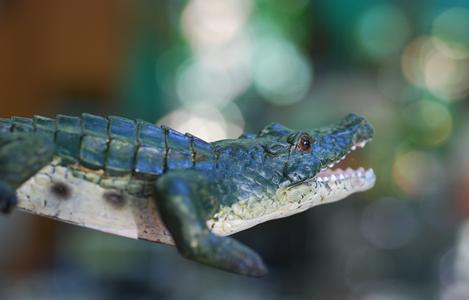|
Cruising with crocodiles in Rainforest 
Photograph
by Preeti Verma Lal
"Oh, yes, Scarface is burly. As macho as a male can get. I hate it when people call him dangerous. I loathe the ‘instinctive killer’, ‘an opportunistic predator’ adjective that is often thrown at him. My heart bleeds for Scarface. You’d be surprised how shy he is. He is definitely not devious. He is cautious; he’ll slink off if he sees you”. Sitting in the heart of Daintree Rainforest (a 60-minute drive from Port Douglas in northern Australia), I thought Bruce Belcher was talking of a dear friend who has been scarred by the world’s vitriol.
“You want to see Scarface?” Belcher sprang from the chair and pointed to a photograph. There, he was. Scarface. Large head. Broad body. His skin dark greenish-drab. A pair of ridges running from the eyes along the centre of the snout; the scales oval; the scutes small. His weight: Roughly 700 kilograms. His head: 200 kilograms. Scarface looked macho. As macho as a crocodile can get. Yes, Scarface is an estuarine crocodile. The alpha-male in the Daintree River , with a harem of six females and a territory spread over 30 kms.
I was in Daintree Rainforest, a World Heritage Site, for a crocodile spotting cruise. Mind it, this is no ordinary jungle. Daintree Rainforest is the largest continuous tropical rainforest in Australian continent and is home to rare species of flora and fauna, including the saltwater crocodile, the largest of all living reptiles. Call them estuarine or Indo-Pacific crocodile, but in Daintree, these saltwater crocodiles are ‘salties’. And there are a bunch of nearly 70 adult crocodiles that live in the Daintree Rainforest.
“70 adult male-crocs?” I whooped. “Do I get to see half of them?” I was getting impatient. And greedy. “Half? No, lower your expectation. Daintree is actually a low-density croc population; the average being 1.3 adults per square kilometre.” I stood corrected by Belcher. My enthusiasm petered but Belcher promised a few big crocs. A few hatchlings too. Lizzy, Daintree’s prima donna of a croc, had a litter recently and the hatchlings could be seen on the banks eyeing and prowling for crabs and prawns. I took to Belcher’s neat promise. I’d believe him. He sure knows all about crocs. In the past 25 years, he has done 40,000 croc-spotting cruises. Perhaps that is why he is demystifying all killer-croc tags. Perhaps that is why his heart bleeds for the crocs who were mercilessly massacred for their exquisite skin until a law was promulgated in 1974 to protect Australian crocs.
Even before I hopped on the MV Mangrove Jack II for a one-hour cruise, Belcher had converted me into a croc-lover. Then came a loud warning: “Walk carefully through the Boardwalk. There are amethystine pythons”. Ken White, the guide/boatman added more slithery intrigue to the croc-cruise. I looked around, dreading a hiss and fearing a sting. But I got distracted by White’s stern safety instructions. “If you see a croc, keep your arm in. Do not scream. Do not feed the crocs. We cannot get closer than 10-metres from the croc, so do not expect to get really up, close and personal with them”.
I gulped every warning. I heeded to every advice. When Jack II engine growled and glided on the 120-km long Daintree River, I snaked the binocular around my neck and squinted to peep within the murky waters. White began the story about mangroves and pneumatophores and interspersed it with the story of Lizzy, her babies, Scarface and the territorial wars between the dominant male croc and the wannbes alphas. Suddenly, there was a hush – White silenced the engine, sshhhed all of us and ordered, “Look at the fallen log. Peer under the yellow leaves. That’s Lizzy baby. A 2011 model. A two-year old croc”. But Lizzy’s little baby was so well camouflaged that I could barely distinguish her pale yellow/ black striped skin from the brown of the pneumatophores. I saw her. Barely 36-inches long, Lizzy’s baby looked like a cuddly toy. “You think she is cuddly. Wait, till this one grows up. It could be 5 metres long. Maybe you could cuddle then!” White guffawed at my cuddle-thought. He was right – the salties are the only extant crocodilian to regularly reach or exceed a length of 4.8 metres (16 ft).
I dropped all thoughts of cradling a croc and yearned to see Scarface. “Perish the thought”. White vetoed all possibility of seeing the alpha male. A couple of days ago, Scarface had a kinda brawl with the younger male-crocs who wanted to vanquish Scarface and usurp his territory. And his harem of six. That day, he was bruised and sulking somewhere by the messy compost mounds that they call home. Scarface was missing but I saw Lizzy and another of her babies. Lizzy had laid 70 eggs, incubated them for three months but not more than 25 hatched. In the croc-world, a 25-hatchling out of 70 eggs is the basic law of averages.
As Lizzy glided into the waters and White steered Jack II back to the bank, I found Belcher standing with a croc skull in hand. “Look at this one. It probably got killed, its skin turned into a dainty purse for a vain woman,” he said with disdain. “I’ll never let this happen to other Salties”. Belcher made a promise to himself. I joined the chorus. Salties are a formidable reptile. They surely are no brute!
The Crest Edition, February, 2013
|

